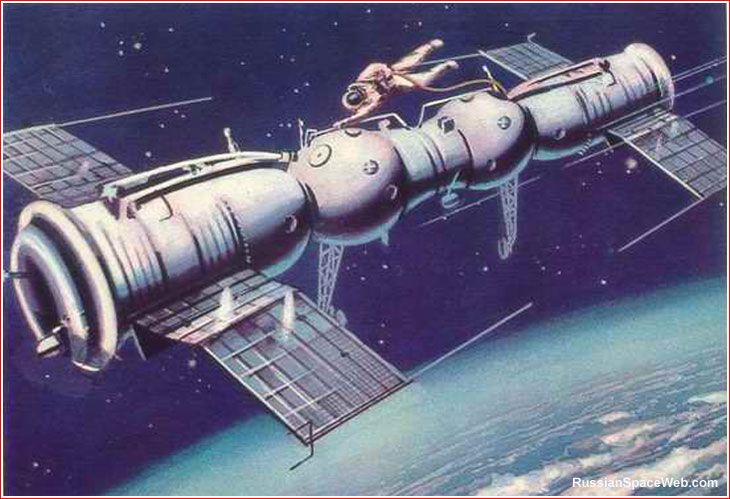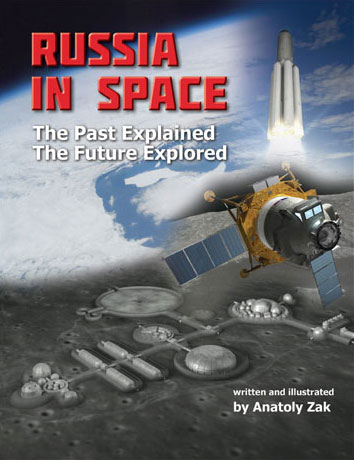Vladimir Komarov's tragic flight aboard Soyuz-1 (original) (raw)
Soyuz-1 flight program
From the outset, the primary goal of the Soyuz 7K-OK project was to serve as a rehearsal of rendezvous in space in support of the L1 and L3 lunar exploration programs. To meet this goal, early missions of the Soyuz spacecraft had always included a dual flight.
Previous chapter: Politics behind the first Soyuz mission

A Soviet-era painting depicting transfer between two Soyuz spacecraft.
From the publisher: Pace of our development depends primarily on the level of support from our readers!
According to the flight program, the Soyuz-1, (designated 7K-OK No. 4) would be launched first from Site 1 in Tyuratam, piloted by Vladimir Komarov. The spacecraft would be equipped with an "active" docking mechanism, making it responsible for most maneuvers during the rendezvous.
A day later, the second Soyuz (7K-OK No. 5), equipped with a "passive" docking port, and carrying three cosmonauts under the command of Valery Bykovsky would follow. Its liftoff from Site 31 was timed within a 50-second window when the first spacecraft would be passing over the launch site. The launch time was also chosen to ensure the landing of both spacecraft in daylight conditions.
The two vehicles would linkup during the 17th orbit for the first spacecraft and just between 45 and 50 minutes after the separation of the second ship from the launch vehicle on the daylight side of the orbit.
After the successful docking, Aleksei Eliseev and Evgeny Khrunov on Soyuz-2 would don their Yastreb spacesuits and exit their ship via a hatch in the habitation module. Their exit was timed to take place between two and four minutes before entering the range of ground control stations on the Soviet territory, also on the daylight part of the orbit. It would provide good conditions for filming and for thermal control of spacesuits.
The pair of spacewalkers would have around 54 minutes to crawl from Soyuz-2 to Soyuz-1 through the vacuum of space, while remaining in direct contact with ground control. The two cosmonauts would return to Earth along with Komarov, while Bykovsky onboard Soyuz-2 would touch down alone. (246)
The two spacecraft were to remain docked for a full day, while keeping their solar panels pointed toward the Sun, possibly under manual control.
From Mishin's notes, it appears that during a meeting on January 17, Gagarin also proposed to conduct a second docking of the two spacecraft, this time under full manual control, probably after the successful first rendezvous in the automated mode. It is not entirely clear, whether his proposal was included into the final program, but as late as three weeks before launch, Mishin mentioned the provisions for the second docking in his notes detailing the mission.
Following undocking, the passive Soyuz-2 (Vehicle No. 5) would conduct all the separation maneuvers with its DPO thrusters to save propellant on the active ship. According to a plan finalized on April 15, following the separation, the two ships would be in free drift for five seconds, after which the passive vehicle would perform a 15-second separation burn with its DPO thrusters delivering 0.6 meters per second in velocity. After a three-minute 20-second drifting period, the passive Soyuz will fire its DPO engines for another 20 seconds completing the separation maneuver.
It appears that some kind of military experiment designated V-8 was planned for one of the ships during the 50th orbit (4th day) of the mission, probably involving observations of ground targets. As late as April 15, it was decided to use only the smaller DO orientation thrusters rather than the DPO engines to keep the vehicle in correct attitude during the experiment, thus limiting the expenditure of propellant to nine kilograms. Overall, fuel expenditure during the rendezvous remained a major concern for Mishin as late as mid April, prompting his consultations with top rendezvous expert Boris Raushenbakh.
The return to Earth for both spacecraft would be timed during daylight hours at the primary landing sites. (774)
Next chapter: Soyuz-1 crew training
Read much more about the history of the Russian space program in a richly illustrated, large-format glossy edition:
The article and photography by Anatoly Zak; Last update:January 11, 2018
Page editor: Alain Chabot; Last edit: April 26, 2017
All rights reserved
